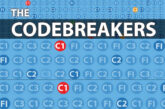
Need help with cracking those EICR codes? The technical team at NAPIT, with the help of the 18th Edition Codebreakers publication, answer your latest coding queries. Click on the photos for a closer look!
MAHMOOD HASSAN:
I SAW THIS ON A RECENT INSPECTION, SO I ASKED THE OWNER TO CALL THE CHAP WHO DID IT AND PUT ME ON THE PHONE TO HIM. I ASKED HIM WHERE THE EARTH WAS, AND HE TOLD ME IT WAS THE SCREW!!! I THEN ASKED HIM WHAT KIND OF EARTHING SYSTEM IT WAS, AND HIS RESPONSE WAS “SCREW IN BRICK, BRICK CONNECTED TO EARTH, INNIT”. NEEDLESS TO SAY, I WALKED AWAY FROM THE JOB. MAYBE THE IET WILL CONSIDER IT FOR THE 19TH EDITION!
 The lack of regard for not only the occupants of the property, but any returning maintenance inspector or electrician, is totally unacceptable. Bypassing both of the RCDs on a dual RCD to mask the deficient wiring is very dangerous, especially if the occupant is under the impression they have RCD protected circuits. With so many circuits and situations now requiring RCD protection, there are literally dozens of probable Regulation infringements, observations, and Codes. By looking at the Earth bar in the CU, we can only see the Main Earth Conductor (MEC) and the circuit CPCs. This can mean that either the main protective bonding isn’t required (incoming plastic services), they’re connected via an external marshalling bar, or they aren’t present. If they aren’t present, and there is no supplementary bonding in the bathroom, the observations and codings are immediately going to be looking at C2 or FI, for this special location alone. If any of the socket-outlets are, or could be supplying an appliance outside, and don’t have RCD protection, as an industry we have taken this to attract a Code C2.
The lack of regard for not only the occupants of the property, but any returning maintenance inspector or electrician, is totally unacceptable. Bypassing both of the RCDs on a dual RCD to mask the deficient wiring is very dangerous, especially if the occupant is under the impression they have RCD protected circuits. With so many circuits and situations now requiring RCD protection, there are literally dozens of probable Regulation infringements, observations, and Codes. By looking at the Earth bar in the CU, we can only see the Main Earth Conductor (MEC) and the circuit CPCs. This can mean that either the main protective bonding isn’t required (incoming plastic services), they’re connected via an external marshalling bar, or they aren’t present. If they aren’t present, and there is no supplementary bonding in the bathroom, the observations and codings are immediately going to be looking at C2 or FI, for this special location alone. If any of the socket-outlets are, or could be supplying an appliance outside, and don’t have RCD protection, as an industry we have taken this to attract a Code C2.
In truth, from the picture we can’t know if either of these is true of this installation, but we can pass comment on the information we’re given. The inspector has also indicated that the wiring has deteriorated, which means the insulation resistance (IR) is likely to have broken down on some circuits, causing the RCD to trip, which is probably the reason for the bypass of the RCDs. This will also attract an adverse Code if the values obtained fall below those in Table 64 of BS 7671, and after investigation, prove the wiring is sufficiently deteriorated, to require replacement.
The bottom line is, although the RCDs are present but deliberately bypassed, the installation will only attract adverse Codes from a lack of adequate protection in a room containing a bath or shower (Section 701), or socket-outlets supplying equipment outside, or excessively low IR readings on the installation wiring. In bypassing the RCDs in this way, the resultant danger from inappropriately marked isolators can now also jeopardise the safety of anyone carrying out maintenance or the occupier isolating via an RCD, thinking the power is off.
We should always practice safe isolation before we work on any electrical installation, so Karl has done the right thing and checked before doing any work. Also, the Neutral bar is not configured for a dual side set-up, as it now has a non-manufacturer constructed conection between the two bars, effectively connecting the two neutrals from each of the split side together. This is also likely to cause unwanted tripping from one side of the board to the other (see Regulation 531.3.2).
Even though isolation in accordance with Regulation 462.1.201 exists here, if the occupants go to isolate one side of the board in an emergency, thinking they have isolated for safety, and the power is still on, this has the potential for serious injury and must be coded accordingly.
Find out how you can purchase a copy of the NAPIT Codebreakers publication by clicking here








